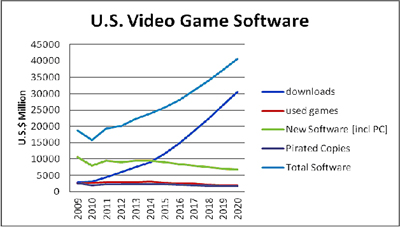
November 17, 2025


 The major factor differentiating the first decade from the second is the importance of digital downloads. While these began in the late eighties, they really only started to gain traction at the beginning of this century. Now, the migration is clearly gaining speed with the appearance of new ways to access games – the iPhone, the iPad, OnLive and Gaikai, Chrome TV etc.
The major factor differentiating the first decade from the second is the importance of digital downloads. While these began in the late eighties, they really only started to gain traction at the beginning of this century. Now, the migration is clearly gaining speed with the appearance of new ways to access games – the iPhone, the iPad, OnLive and Gaikai, Chrome TV etc.  GameStop typically takes about 20% from the $60 retail of a boxed game, or about $12. These twelve dollars mean that the publishers’ sales will increase by 25% every time they sell online as opposed to via retail. In terms of their profit margin, the picture is much more enticing - it will nearly triple.
GameStop typically takes about 20% from the $60 retail of a boxed game, or about $12. These twelve dollars mean that the publishers’ sales will increase by 25% every time they sell online as opposed to via retail. In terms of their profit margin, the picture is much more enticing - it will nearly triple.
| Type | 2010 $million | 2020 $million | +/- |
| Downloads | 3,100 | 30,500 | +883.0% |
| Used Games* | 2,800 | 1,800 | -35.72% |
| New Games Incl PC Games* | 7,910 | 6,700 | -15.30% |
| Pirated Games* | 1,990 | 1675 | -15.80% |
| Total Games | 15,800 | 40,675 | +182.0% |
Over the last decade videogame brands have become entrenched in the public’s consciousness as much as any other entertainment-driven property, but for some inexplicable reason(s) the industry has been painfully slow to embrace licensing and its powerful brand-building and revenue-generating capabilities. With the exception of Halo action figures and construction toys from Megabloks, and a robust and successful program for Angry Birds, licensing for major videogame brands is virtually absent from the marketplace. In an industry where the cost of production continues to escalate and profit margins are being squeezed, why don’t videogame companies maximize the profit-making opportunities of their brand assets like their counterparts in TV or filmed entertainment such as Disney, Nick, and Warner Bros.?
Companies like Activision and Take Two are leaving millions of dollars in incremental royalty revenue on the table by ignoring the power of licensing. Their primary rationale against licensing is that many of their games – Call of Duty and Grand Theft Auto -- are rated “M” for Mature, and the perception is that a lot of licensed product is directed toward kids. Fair enough, but plenty of licensed products target an adult audience, and the reality is that kids as young as 8 or 9 are playing these games anyway. Also, even if a parent won’t allow a child to play the videogame, they might be willing to buy them an action figure or t-shirt. Thus, licensed products can serve as an on-ramp for future consumers to eventually purchase the core videogame product.
The other primary reason why these companies hold back is they see licensing as potentially tarnishing their brand equity, but in reality their fears are greatly overblown. Licensors retain total control over the type of merchandise and every step of the product approval process, including retail distribution. Licensing, when done well, can be an incredibly potent marketing tool, and represents the only marketing strategy that also generates revenue to help fund other marketing initiatives and re-investment in new product development. Consumers become brand ambassadors who pay you for the right to help advertise your brand!
Videogame companies have overlooked the power of licensing to their own detriment. The company that figures out how to create great content and support it with a sound merchandising program will be light-years ahead of the competition.He may have a point. In the case of Hasbro, license income - mainly for Transformers and G I Joe - amounted to $136 million or about 3.4% of total worldwide sales in 2010. The publishers could, were they to equal this performance, walk away with another $125 million per year by 2020 for the U.S. market alone, and probably a multiple of this number worldwide.
Copyright © 2025 TDmonthly®, a division of TOYDIRECTORY.com®,
Inc.